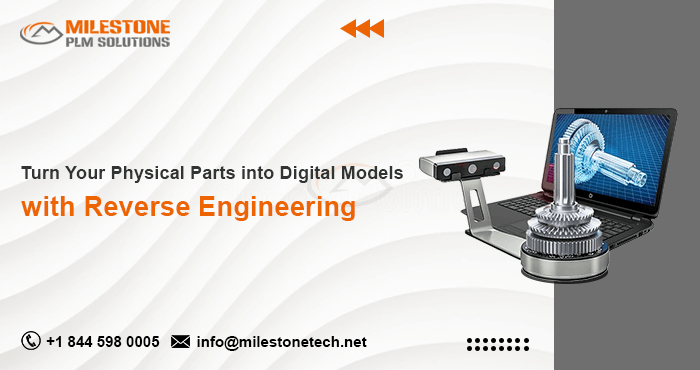Turn Your Physical Parts into Digital Models with Reverse Engineering

The physical world is bursting with unique shapes and designs. But how do you capture these creations and bring them into the digital realm? This is where reverse engineering comes in, a powerful process that allows you to transform physical objects into digital 3D models.
exploring its applications across industries and cultures. We’ll break down the process, discuss the technology involved, and unveil the exciting possibilities it unlocks for makers, inventors, and businesses around the globe.
From Legacy to Digital: Unveiling the Power of Reverse Engineering
Imagine a scenario – you have a treasured family heirloom, a tool with a broken replacement part, or a vintage car missing a specific component. Traditionally, replicating these objects involved manual measurements, skilled craftsmanship, and sometimes, a bit of trial and error. Reverse engineering offers a more efficient and accurate solution.
In essence, reverse engineering is the process of deconstructing a physical object to understand its design and functionality and then creating a digital representation of it. This digital model, typically a 3D file, can then be used for various purposes, including:
- Replication: Create exact replicas of existing parts, vital for preserving cultural artifacts, restoring vintage machinery, or replacing broken components.
- Modification: Modify existing designs to improve functionality, add features, or adapt them for different uses.
- Innovation: Analyze the design of competitor products or historical artifacts to inspire new inventions and product development.
- Digital Archiving: Create a permanent digital record of physical objects, particularly important for preserving cultural heritage and historical artifacts.
The applications of reverse engineering are truly transnational, impacting diverse fields around the world. Here are some specific examples:
- Cultural Preservation: Archaeologists in Egypt can use 3D scanning to capture intricate details of ancient artifacts, allowing for digital preservation and global accessibility.
- Automotive Industry: Car manufacturers in Germany can utilize reverse engineering to analyze competitor designs, identify areas for improvement, and accelerate their own vehicle development.
- Aerospace Engineering: Engineers in India can leverage 3D scanning to create digital models of legacy aircraft parts, ensuring continued maintenance and operation.
- Prosthetic Design: Medical professionals across the globe can use reverse engineering to create custom-fit prosthetics that perfectly match a patient’s anatomy.
Demystifying the Process: How Reverse Engineering Works
The core steps involved in reverse engineering a physical object can be summarized as follows:
- Data Acquisition: This is the initial stage where the physical object’s geometry is captured. The most common technology used is 3D scanning, which employs lasers, structured light, or other techniques to generate a digital point cloud representation of the object’s surface.
- Data Processing: The raw scan data often requires post-processing to eliminate noise, fill in missing information, and create a more usable 3D model. This may involve software tools for mesh cleaning, smoothing, and surface reconstruction.
- 3D Modeling: The processed data is then converted into a usable 3D model format such as a triangular mesh or a NURBS surface. Depending on the intended use, this model may be further refined in CAD (Computer-Aided Design) software to create a fully functional and manufacturable digital representation.
Tools of the Trade: Unveiling the Technology Behind Reverse Engineering
Several technologies play a crucial role in the reverse engineering process:
- 3D Scanners: These devices come in various types, each with its strengths and limitations. Structured light scanners are relatively affordable and work well for simple geometries. Laser scanners offer higher accuracy and detail but come at a higher cost. For capturing internal structures, CT scanning (computed tomography) can be used.
- 3D Printing: Once a digital model is created, 3D printing allows for the physical reproduction of the object, making it ideal for creating replicas or prototypes.
- CAD Software: Software like AutoCAD, SolidWorks, or CATIA provides tools for refining the 3D model, adding details, and creating production-ready drawings or models.
The Future of Reverse Engineering: A Globalized Approach
As technology continues to evolve, reverse engineering is poised to become even more accessible and impactful. Here’s what we can expect:
- Increased Affordability: With advancements in 3D scanner technology and software, the cost of reverse engineering is expected to decrease, making it more accessible to a wider range of users.
- Portability and Ease of Use: Compact and user-friendly 3D scanners will become more commonplace, enabling on-site data capture and simplifying the process for individuals and businesses globally.
- Cloud-Based Solutions: Cloud platforms can streamline the reverse engineering workflow by providing access to processing power, storage, and collaborative tools for geographically dispersed teams.
Conclusion
Follow Milestone PLM Solutions for Mechanical Industry Updates, CAD Tips and Global Mechanical News.
Milestone PLM Solutions with its exclusive delivery center in India is a global CAD, CAM & FEA services outsourcing partner serving the needs of the Mechanical, Millwork and Automotive industry since 2004. MILESTONE focuses on the unique needs of clients and believe in tackling real-life problems with efficiency, smooth and ease.
The MILESTONE team can assist you with Product Design, 3d Modeling, Drafting & detailing, Reverse Engineering, FEA Analysis and more. We support multiple software including AutoCAD, Solidworks, Catia, NX, Inventor, Solidedge & Ansys etc. Our approach is to provide a dedicated team for each customer over ongoing project and deliver the quality output consistently.
With our state of art technology and large talent pool of Engineers, we are developing best in class solutions for our customers across the globe. We align with your culture and values to form unbreakable partnerships and are primed for success with over 100 employees and 150 customers in the US, Europe, India, and Asia.
You can email us at info@milestonetech.net and can log in to our website www. milestonetech.net to know more about our services and our work portfolio or contact us on +1-844-598-0005
